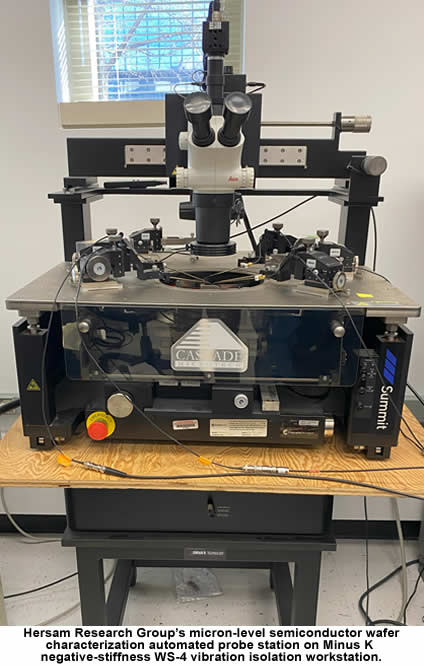|
|
Newsletter May 2025 | Menu of
Newsletters
|
The lab has
pushed the limits of semiconductor wafer characterization in microscale
electronic devices. Facilitating this research is Negative-Stiffness vibration
isolation.
|
|

|
The Hersam
Research Group – part of the Department of Materials Science &
Engineering, McCormick School of Engineering & Applied Science, at
Northwestern University studies, develops and manipulates hybrid hard and soft
nanoscale materials for applications in information technology, biotechnology,
nanotechnology and alternative energy. The labs advanced electronic and
chemical characterization techniques provide deep insight into these areas,
with key examples including impedance spectroscopy for photovoltaics and
scanning conductive ion microscopy for lithium ion batteries. Such techniques
offer a better understanding of the key issues in enabling practical
applications of these technologies.
Micron-Level, Wafer
Characterization
Another of the groups areas of interest is
semiconductor micron-level, wafer characterization. Wafers, being a thin slice
of semiconductor, such as crystalline silicon, are used for the fabrication of
integrated circuits, and in photovoltaics, to manufacture solar cells. The
wafer serves as the substrate for microelectronic devices built in, and upon
the wafer.
During semiconductor device manufacturing, wafer testing is
performed, where all individual integrated circuits that are present on the
wafer are tested for functional defects by applying special test patterns. The
wafer testing is performed by a piece of test equipment called a wafer prober.
For electrical testing, a set of microscopic contacts or probes, called a probe
card, are held in place while the wafer, vacuum-mounted on a wafer chuck, is
moved into electrical contact.
The Hersam Research Group has developed a
digital wafer map, allowing thousands of devices to be probed in an automated
fashion.
On some of these devices we have 1,000 transistors to
characterize inside of a small sample, said William A. Gaviria Rojas, with the
Hersam Research Group. We are using an automated probe station, manufactured by
Cascade Microtech, for semiconductor micron-level, wafer scale characterization
on the devices we fabricate.
Before, the experiments were performed
with a manual probe station, taking 1 3 hours to complete. Then, the lab
switched to the automated probe station which enabled it to collect data for 2
3 days.
The manual process did not display small misalignments in the
movement of the probes over the 1 3 hour characterization, continued Rojas. But
the longer 2 3 day characterization experiments showed considerable
interruptions during high traffic times the small probes that were in contact
with the devices were losing contact.
We were looking for a vibration
isolation solution that would require low maintenance, with no additional
things like compressed air or electricity, explained Rojas. For these reasons
we selected the Minus K, Negative-Stiffness WS-4 compact vibration isolation
table.
Vibration Isolation
The Group determined that the
problem was vibration caused by people walking by, opening and closing doors
in, and near, the lab where the probe station was located. There was also
vacuum and pump equipment located in the room which created
vibration.
The probe station was positioned on top of cinder blocks,
with plastic material between. This was the extent of vibration isolation being
employed, which was inadequate.
A typical laboratory will almost always
position sensitive micron-level instrumentation on a vibration isolation
platform. Isolating such imaging equipment against low-frequency vibration has
become increasingly more vital to maintaining imaging quality and data
integrity. Indeed, the labs other Raman and AFM instrumentation all have a more
sophisticated level of vibration isolation in place.
Full
article... |
|
|
The
MK52
Series Vibration Control Optical Table with more ergonomic comfort is designed
specifically for ultra-low natural frequency applications. The system utilizes
Minus K's patented negative stiffness vibration isolators to provide a compact,
passive optical table with ultra-low natural frequencies, higher internal
structural frequencies, and excellent vertical and horizontal isolation
efficiencies.
- Ultra-Low
Natural Frequencies
- Vibradamped Frame
- Customizable
Accessories
- No Air Supply
Needed - Easy to Use
- Choice of Tabletops
- Ergonomic
Styling
More...
Pricing &
sizes for MK52 |
|
|
Congratuations 2023-2024 Winners: Minus
K Technology's Vibration Isolator
Educational Giveaway
to U.S. Colleges
and Universities |
|
“Giving back
to academia always gives us great feeling.” says Minus K’s President
Steve Varma. “When talking to students at our booth at the different trade
shows and elsewhere, there is always a great interest in getting isolation
systems for their schools to help with their experiments. We are proud of being
able to provide systems for ten years.” |
|
Winning Proposals for Vibration
Isolantion Projects: |
|
University of
North Texas - Physics Department
The vibration isolator will be used
to stabilize their AFM to achieve high resolution images of grain sizes in thin
films. They will modify these films through different thermal
processes.
Rose-Hulman
Institute of Technology - Physics and Optical Engineering Department
The vibration isolator will be used for experiments in ultra-sensitive
optical measurements and characterization of magneto-optic nanoparticles for
cancer hyperthermia therapy.
Wellesley College
– Chemistry Department
The isolator will for research studies of
pathological changes to excitable cells using fluorescent reporters. They will
use microinjection and electrophysiology on intact worms in vivo and culture
cells using their Nikon Ti-U microscope which currently has too much vibration
movement.
Cornell University
– Applied and Engineering Physics Department
The isolator will
used fabricating novel two-dimensional (2D) material heterostructures by
combining atomically thin 2D materials, such as graphene, hBN, transition metal
dichalcogenides, to explore new electronic and quantum phenomena inside an
MBraun glovebox under an inert argon atmosphere.
Rutgers University
– Physics Department
The isolator will be for a scalable atomic
gravimeter to measure the absolute gravity, the vertical gravity gradient, and
the third-order vertical derivative by dropping three spatially separated
cold-atom cloud and forming atom interferometry, to a retroreflector under a
vacuum chamber.
Sam Houston State
University – Biological Sciences
The isolator will assist in
fluorescent and phase contrast imaging using an ECHO Revolve upright/inverted
microscope, allowing publication-quality fluorescence, phase, and darkfield
imaging to graduate and undergraduates in research or doing live-cell
video.
Next Giveaway to be
Announced August 2025l Stay tuned to these eletters.
Questions can be
addressed to giveaway@minusk.com |
|
| Check out previous
Educational Giveaway winners: |
|
|
|
|
Previous
Newsletters
|

 |
|
|
